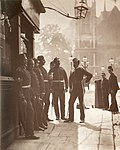Statue of Henry Irving, London
1910 establishments in the United Kingdom1910 sculpturesGrade II listed statues in the City of WestminsterLondon stubsMonuments and memorials in London ... and 3 more
Outdoor sculptures in LondonSculptures of men in the United KingdomUnited Kingdom sculpture stubs

The statue of Henry Irving is located on the grounds of the National Portrait Gallery along Charing Cross Road in London, United Kingdom. It was erected on 12 May 1910 by English actors and actresses and others related to British theatre in a campaign organized by the Irving Memorial Committee. It was installed on land donated by the City of Westminster. The Irving Society hosts a wreath-laying ceremony at the statue on 6 February each year, commemorating the actor's birth. The bronze statue and Portland stone pedestal is by the sculptor Thomas Brock and is Grade II listed.
Excerpt from the Wikipedia article Statue of Henry Irving, London (License: CC BY-SA 3.0, Authors, Images).Statue of Henry Irving, London
Irving Street, City of Westminster Covent Garden
Geographical coordinates (GPS) Address Nearby Places Show on map
Geographical coordinates (GPS)
| Latitude | Longitude |
|---|---|
| N 51.50968 ° | E -0.12821 ° |
Address
Sir Henry Irving
Irving Street
WC2H 0EP City of Westminster, Covent Garden
England, United Kingdom
Open on Google Maps









